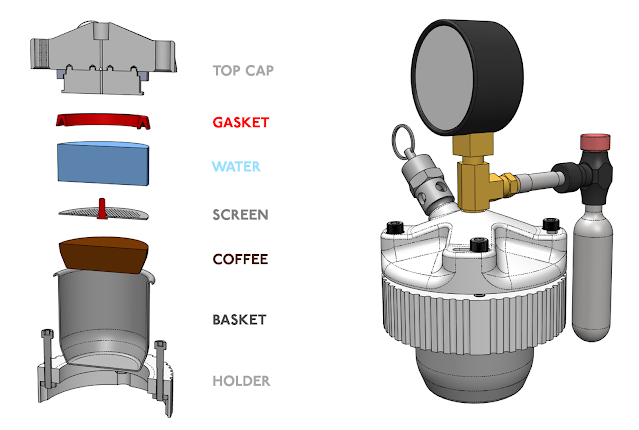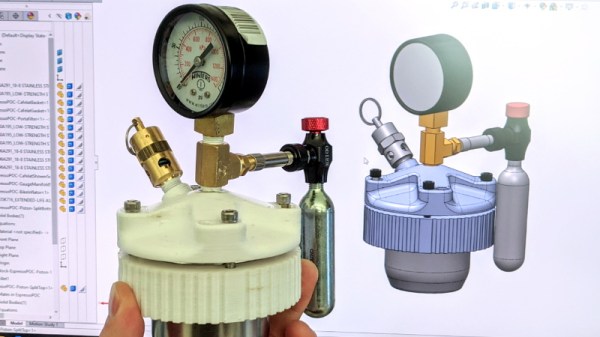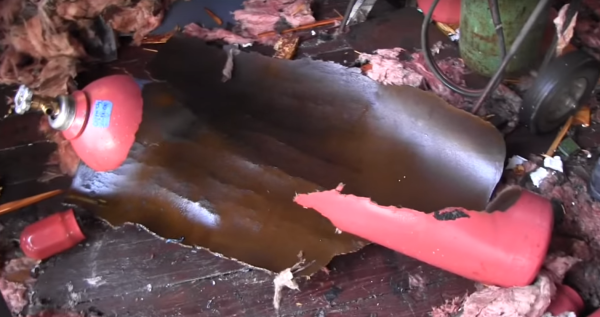Virtually any hobby has an endless series of rabbit holes to fall into, with new details to learn around every corner. This is true for beekeeping, microcontrollers, bicycles, and gardening (just to name a few), but those involved in the intricate world of coffee roasting and brewing turn this detail dial up to the max. There are countless methods of making coffee, all with devout followers and detractors alike, and each with its unique set of equipment. To explore one of those methods and brew a perfect espresso, [Eric] turned to his trusted 3D printer and some compressed gas cylinders.
 An espresso machine uses high pressure to force hot water through finely ground coffee. This pressure is often developed with an electric pump, but there are manual espresso machines as well. These require expensive parts which can withstand high forces, so rather than build a heavy-duty machine with levers, [Eric] turned to compressed CO2 to deliver the high pressure needed.
An espresso machine uses high pressure to force hot water through finely ground coffee. This pressure is often developed with an electric pump, but there are manual espresso machines as well. These require expensive parts which can withstand high forces, so rather than build a heavy-duty machine with levers, [Eric] turned to compressed CO2 to deliver the high pressure needed.
To build the pressure/brew chamber, he 3D printed most of the parts with the exception of the metal basked which holds the coffee. The 3D printed cap needs to withstand around nine atmospheres of pressure so it’s reasonably thick, held down with four large bolts, and holds a small CO2 canister, relief valve, and pressure gauge.
To [Eric]’s fine tastes, the contraption makes an excellent cup of coffee at minimal cost compared to a traditional espresso machine. The expendable CO2 cartridges only add $0.15 to the total cost of the cup and for it’s simplicity and small size this is an excellent trade-off. He plans to improve on the design over time, and we can’t wait to see what he discovers. In the meantime, we’ll focus on making sure that our beans are of the highest quality so they’re ready for that next espresso.



 On the morning of September 26th, 2013 the city of Orlando was rocked by an explosion. Buildings shook, windows rattled, and Amtrak service on a nearby track was halted. TV stations broke in with special reports. The dispatched helicopters didn’t find fire and brimstone, but they did find a building with one wall blown out. The building was located at 47 West Jefferson Street. For most this was just another news day, but a few die-hard fans recognized the building as Creative Engineering, home to a different kind of explosion: The Rock-afire Explosion.
On the morning of September 26th, 2013 the city of Orlando was rocked by an explosion. Buildings shook, windows rattled, and Amtrak service on a nearby track was halted. TV stations broke in with special reports. The dispatched helicopters didn’t find fire and brimstone, but they did find a building with one wall blown out. The building was located at 47 West Jefferson Street. For most this was just another news day, but a few die-hard fans recognized the building as Creative Engineering, home to a different kind of explosion: The Rock-afire Explosion. Many of us have heard of the Rock-afire Explosion, the animatronic band which graced the stage of ShowBiz pizza from 1980 through 1990. For those not in the know, the band was created by the inventor of Whac-A-Mole, [Aaron Fechter], engineer, entrepreneur and owner of Creative Engineering. When ShowBiz pizza sold to Chuck E. Cheese, the Rock-afire Explosion characters were replaced with Chuck E. and friends. Creative Engineering lost its biggest customer. Once over 300 employees, the company was again reduced to just [Aaron]. He owned the building which housed the company, a 38,000 square foot shop and warehouse. Rather than sell the shop and remaining hardware, [Aaron] kept working there alone. Most of the building remained as it had in the 1980’s. Tools placed down by artisans on their last day of work remained, slowly gathering dust.
Many of us have heard of the Rock-afire Explosion, the animatronic band which graced the stage of ShowBiz pizza from 1980 through 1990. For those not in the know, the band was created by the inventor of Whac-A-Mole, [Aaron Fechter], engineer, entrepreneur and owner of Creative Engineering. When ShowBiz pizza sold to Chuck E. Cheese, the Rock-afire Explosion characters were replaced with Chuck E. and friends. Creative Engineering lost its biggest customer. Once over 300 employees, the company was again reduced to just [Aaron]. He owned the building which housed the company, a 38,000 square foot shop and warehouse. Rather than sell the shop and remaining hardware, [Aaron] kept working there alone. Most of the building remained as it had in the 1980’s. Tools placed down by artisans on their last day of work remained, slowly gathering dust.








